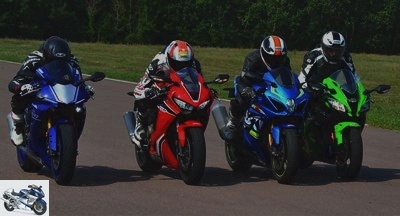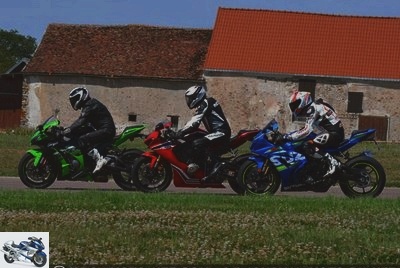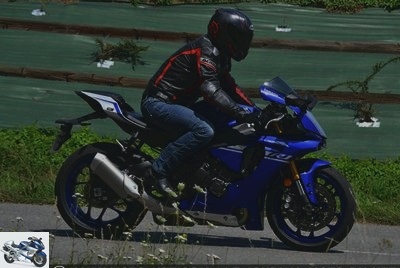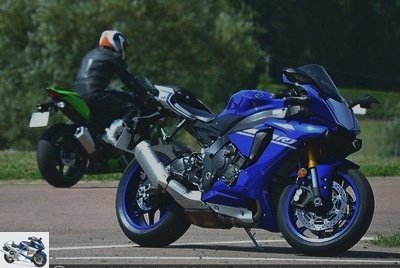2017 Superbike comparison: CBR1000RR, GSX-R1000R, YZF-R1, ZX-10R

The 2017 vintage of Japanese hypersport motorcycles is exceptional: the sharp Kawasaki ZX-10R and Yamaha R1 are in top form, while the Honda CBR1000RR and Suzuki GSX-R1000 have finally returned to sport and technology.. Site contrasts these four thin 1000 cc blades on the road and on the circuit in an exclusive Superbike comparison on the web !
CBR1000RR, GSX-R1000R, YZF-R1, ZX-10R – Page 2: Road test
Until their complete overhaul this year, opting for a CBR1000RR or GSX-R1000 for road use was a reasonably good choice. Despite obvious constraints linked to their nature as sports motorcycles, the Honda and especially the Suzuki provided a certain form of comfort, in contrast to the sharp radicality of the ZX-10R and R1 track beasts..

But that was before: in 2017, the Fireblade and the "Gex" ignore compromises and in turn embrace the "ready to race" approach of the Kawasaki and the Yamaha. Dictated by pure performance, this bias is especially palpable on the CBR1000RR: the Tokyo bike has become so thin and compact that its size is more reminiscent of a Supersport than a Superbike. !
Hyperfine between the legs – it is the narrowest of the four – the Honda reveals a Spartan welcome and pronounced support on its narrow half-handlebars. The upper body is curved forward, the feet are perched far to the rear, and tall builders are not particularly well accommodated. The hardness and the cramped character of its saddle, the least comfortable of this comparison, complete its range of demanding sportsman.
This typical ergonomics does not favor low-speed evolutions, nor the painfully stiff calibration of its Showa suspensions: the slightest imperfection of the bitumen is broadcast sharply, far from the almost padded absorption of the old Fireblade. Add to that the anecdotal protection provided by its ridiculously small bubble – the least efficient of the bunch – and you have a binding motorcycle on the road..

In the same vein, the ergonomics of the R1 immediately plunge into a sporting universe. A little more voluminous than the CBR – mainly because of its wider saddle -, the Yamaha does not amuse the gallery … The joints suffer from the significant tilting on the front, the fault of half-handlebars like fixed directly to the wheel axle and to a seat on the opposite very high perched: 855 mm, i.e. 30 mm higher than the Gex (825 mm), 23 more than the CBR (832) and 20 more than the ZX-10R (835 mm) !
This posture "buttocks-in-the-air-nose-in-the-bubble" echoes the extreme rigidity of its chassis (an aluminum perimeter, like its three competitors) and its dry suspension calibration, barely more progressive than that of the Honda. In this, the R1 and its short windshield only effective in the dab position sweats the competition! Like some European motorcycles like the RSV4, with which it shares this "XXS" format.
Like the Honda, the Yamaha is indeed a very short motorcycle which literally gives the impression of being united around its well-designed tank. The front axle of the R1 is in the immediate vicinity of the pilot, like that of the CBR, which reinforces this feeling of being in direct engagement with an ultra-responsive machine and capable of rocking from one curve to another. a blink of an eye.
Their silhouette and their weight of anorexic mannequin (only 3 kg separate them) give them devilish maneuverability! Useless in town, Honda and Yamaha hypersports, but damn intoxicating outside by their astonishing ability to dive quickly and precisely in curves !
Two weights, two measures
If the Suzuki has melted well compared to the previous model, this 2017 vintage remains bulkier than the thin CBR and R1, especially at the level of the tank. Its half-handlebars more open and in height confirm this observation, as well as the increased thickness of its handles. When Honda and Yamaha get closer to a 600 cc, the GSX-R1000 rather evokes a 750 cc … and that’s already a very nice compliment !

Its less radical attitude and its almost comfortable saddle (for a sportswoman!) Facilitate its handling, especially when it begins in town. We readily forgive him in these conditions his slight overweight (+ 4 kg Vs R1 and + 7 kg Vs CBR), which is felt especially at low speed then during rapid changes of angle. Its very closed front end is not enough to make it match the confusing vivacity of its compatriots.
A few bends negotiated with each bike confirm this: the "Gex" has certainly gained a lot in agility, but remains a tad more physical than the CBR and the R1, as MNC sensed from its discovery on the Phillip Island circuit (Australia). But it has other advantages, such as its protection: its screen partly preserves the shoulders and the bottom of the helmet, which is very far from being the case with the Yamaha and the Kawasaki but especially with the Honda, a real roadster. !
To avoid spoiling anything, the GSX-R1000R benefits from particularly convincing suspension settings on the road: its splendid BFRC Lite fork marvelously smooths out irregularities in the road, as does its mono-shock absorber. The ZX-10R, which nevertheless uses the same equipment, is much less cordial! However, it remains to be seen how the less advanced suspensions of the standard GSX-R behave….

This more tolerant damping allows the Suz ‘to remain gas in full in the bumpy portions, when the inevitable jolts of the secondary network encourage to surrender with its rivals. Physiologists and osteos will make their fortunes – in order – with the owners of CBR1000R, then R1 and ZX-10R, who are on par or almost in terms of hardness of cushioning and seat. The GSX-R1000R, it, allows to do without massages "post-fluff" !
As for the Kawasaki ZX-10R, it turns out to be the most "pot-bellied" of the four. It is also the longest, which gives it a more elongated position and away from the handlebars. This "old-fashioned" position is added to its less extreme geometry and higher weight to serve agility, as we felt in our static part after comparing the .
The result: the ZX-10R is the heaviest forward and the most difficult to enter in curves … all things considered of course, the reigning world Superbike champion motorcycle obviously not being an anvil! The Ninja simply requires more energy to turn: instruct the pilot to help it by tilting the upper body towards the rope, then enjoying flawless stability – the best of the four Japanese hypersports.
And then, you will tell us: this is how a Superbike is piloted, by getting physically involved! Yes … but no: the opponents of the Green, especially the CBR and R1, twirl with a simple pressure on the footrests … otherwise not adjustable on the four, despite the usefulness of this aspect on the road and on the track. A regrettable shortcoming therefore, especially on the 2017 GSX-R which had it previously!
Engines: large gas plants !
Another aspect that makes the ZX-10R lose valuable points on the road is its engine. Powerful but sharp, it needs to be maintained at 7000 rpm to obtain satisfactory revivals and sensations. And since its "box-clutch" assembly turns out to be the roughest, downshifting to maintain the right revs is not particularly pleasant. Really hollow under 4000 rpm (at around 100 km / h in 6th gear), the Verte caught a cold during our tests at legal speeds..

In addition, its shifter does not adapt well to a moderate pace required on the road: the selector hangs – or even blocks sometimes – when the gears are up without disengaging at low and mid-speeds: designed for racing, the Ninja’s shifter only works perfectly in towers! In this, the double-acting system of the GSX-R is far superior in terms of both pleasure and efficiency, as well as the "simple" shifter of the R1. On the CBR, everything happens "manually" for lack of serial shifter … Fortunately, its box is fast and fairly soft !
The ZX-10R, on the other hand, shines with its perfectly calibrated injection, a little notch above the Honda, a big notch in front of the Suzuki (a little rough on the go-around even in intermediate power mode B) and two good notches. in front of the Yamaha, which suffers from a connection too rough to comfortably maintain the gas net. Its asynchronous timing partly explains this phenomenon which can be minimized – but not eradicated – via the incoming power management control (PWR).
Its Crossplane engine also causes other inconveniences: the R1 is the least flexible, its 4-cylinder reluctant at very low speeds when its rivals move there without flinching in sixth. In addition, this atypical engine releases strong heat surges, much more "stinging" than those – however sensitive – of the GSX-R. At this level, the CBR and ZX-10R are better off.

On the other hand, the Iwata block is incredibly sensational in road use. On the one hand because of its more "rough" character which spices up acceleration, on the other thanks to its bewitching soundtrack: rocky and deep, it evokes a V4 … or the MotoGP M1 of Valentino Rossi. Grand Prix atmosphere right out of the garage: it’s good for the ego … and the kids we stayed behind !
Sonically, the CBR1000RR will also satisfy music lovers with its splendid titanium exhaust from which emerges a powerful rumble, which eclipses the more metallic hiss of the ZX-10R. Yes, you read that right: a Honda that "sings" loudly and fairly, despite the constraints of Euro4! This beautiful soundtrack is accompanied in addition to an excellent engine filling, with a particularly wide and beefy torque range..
- Superbike comparison on MNC :
- Superbike comparison on MNC :
- Superbike comparison on MNC :
- Superbike comparison on MNC :
Sublimated by the featherweight of the Fireblade, this performance gives it very vigorous revivals: the Honda extricates itself from the curves without effort and a lot of liveliness. All served by impeccable traction on the road, as for its rivals. This elasticity is pleasant on the secondary network where driving to the switch is not possible for long … compared to Cruchot hidden in a thicket with binoculars "For your safety" !
Forget the old CBR1000RR with not very sensational accelerations because linear: the novelty 2017 has much more trunk and temperament, even if its 4-legged remains less purveyor of sensations than the Yamaha "CP4". What a metamorphosis from the Honda, now as exhilarating to listen to as to drive in mid-revs.
The GSX-R1000 thrills !
But the prize for mechanical performance goes unquestionably to the GSX-R1000R: if the CBR and the R1 give it the answer up to 6000 rpm, they tilt without hope of returning past this cap. The "Gex" pushes hard from 4000 rpm in a low rumbling … and never stops! The ZX-10R, it points far behind while waiting to reach five-figure speeds which will be more favorable to it. Suffice to say that the road will be long on the Ninja, both literally and figuratively. !

However, the GSX-R1000R does not win all the votes on the road! Certainly, its punch is consensus, but its vibrations pronounced in the handlebars at 4000 rpm, then under the buttocks at around 7500 rpm are quite weary. The CBR1000RR also gives off some annoying sizzle, but less markedly. The ZX-10R and R1, which vibrate yet at certain speeds, are totally forgotten next to the Suz ‘ !
MNC noticed this annoyance on the track when testing the GSX-R1000R at Phillip Island, but it takes on a whole new dimension on a long road trip at steady speed. To the point of regretting the absence of a regulator that would allow you to let go of the handlebars in order to evacuate the provided in the wrists! This is why, on expressways, the Suzuki sees its advantage, created by its better protection and its better padded saddle, melt away … !
However, the motorway occupies a large part of the route taken by the Journal moto du Net to reach the tortuous circuit of Ecuyers, in Beuvardes (02), in order to let go of the bridle of the four Japanese Superbikes and complete our comparison. by a confrontation on track to be discovered in !
Related articles
-
2017 Superbike comparison: CBR1000RR, GSX-R1000R , YZF-R1 , ZX-10R The 2017 vintage of Japanese hypersport motorcycles is exceptional : the sharp…
-
2017 Superbike comparison: CBR1000RR, GSX-R1000R , YZF-R1 , ZX-10R The 2017 vintage of Japanese hypersport motorcycles is exceptional: the sharp Kawasaki…
-
2017 Superbike comparison: CBR1000RR, GSX-R1000R, YZF-R1, ZX-10R The 2017 vintage of Japanese hypersport motorcycles is exceptional: the sharp Kawasaki…
-
2017 Superbike comparison: CBR1000RR, GSX-R1000R , YZF-R1 , ZX-10R The 2017 vintage of Japanese hypersport motorcycles is exceptional: the sharp Kawasaki…
-
2017 Superbike comparison: CBR1000RR, GSX-R1000R, YZF-R1, ZX-10R The 2017 vintage of Japanese hypersport motorcycles is exceptional: the sharp Kawasaki…
-
2017 Superbike comparison: CBR1000RR, GSX-R1000R, YZF-R1, ZX-10R The 2017 vintage of Japanese hypersport motorcycles is exceptional: the sharp Kawasaki…
-
2017 Suzuki GSX-R1000R review: the beauty of Gex Driven by the most recent hypersport motorcycles for lack of developments over the past ten years or so,…
-
Comparison test Kawasaki Z900, Suzuki GSX-S750 and Yamaha MT-09: Election of the best Japanese maxi-mid-size roadster In 2017, Kawasaki further…
-
Comparison test BMW F 700 GS Vs Kawasaki ER-6f Vs Yamaha Tracer 700: on the road ! To complete our first test of the Tracer 700, Yamaha’s new…
-
Comparison test Kawasaki Z900, Suzuki GSX-S750 and Yamaha MT-09: Election of the best Japanese maxi-mid-size roadster In 2017, Kawasaki further…